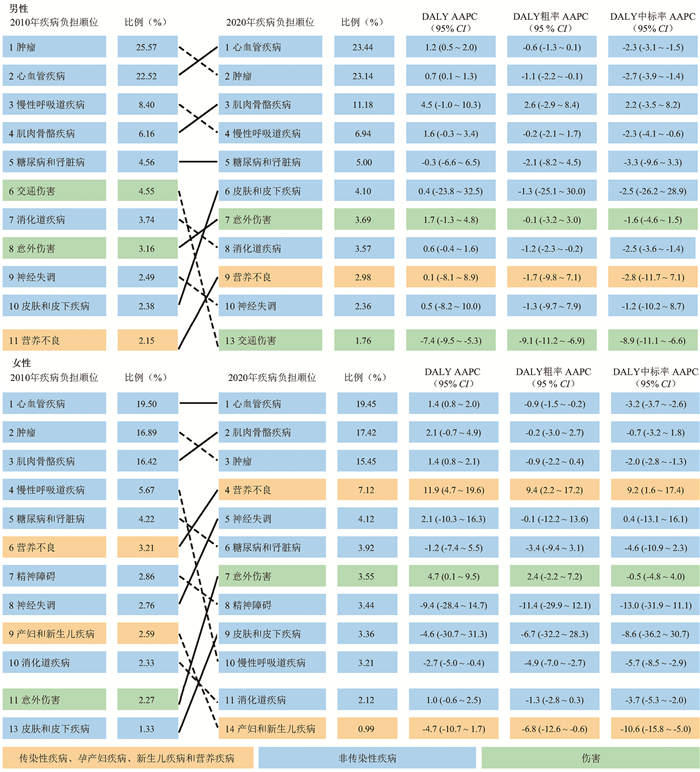Analysis of disease burden in Guangzhou, 2010-2020
-
摘要:
目的 评价2010-2020年广州市人群疾病负担的变化趋势,分析其性别和年龄差异。 方法 使用2010-2020年广州市死因监测数据和人口学数据测算伤残调整寿命年(disability-adjusted life years, DALY),Joinpoint回归分析模型分析DALY的变化趋势。 结果 2020年广州市男女粗死亡率分别为640.87/10万人和464.49/10万人,主要死因为心血管疾病、肿瘤和慢性呼吸道疾病。2010-2020年,男性心血管疾病上升为疾病负担首位,肌肉骨骼疾病、皮肤和皮下疾病、意外伤害和营养不良的疾病负担顺位上升。女性心血管疾病保持疾病负担首位,肌肉骨骼疾病、营养不良、神经失调、意外伤害、皮肤和皮下疾病的疾病负担顺位上升。男性和女性的总DALY基本保持不变,但粗率和中标率呈下降趋势。不同年龄组的疾病负担顺位有所差异。 结论 2010-2020年广州市疾病负担以非传染性疾病为主,不同性别和年龄人群的疾病负担模式具有各自特征。应结合城市层面的主要健康问题,探明危险因素,针对重点人群疾病制定有效的预防控制策略。 Abstract:Objective To evaluate the trend of disease burden in Guangzhou from 2010 to 2020, and to analyze gender and age differences. Methods The disability-adjusted life years (DALY) was calculated using cause-of-death surveillance data and demographic data from 2010 to 2020 in Guangzhou, and the trend of DALY was analyzed using the Joinpoint regression model. Results In 2020, the crude death rates of males and females in Guangzhou were 640.87 and 464.49 per 100 000, respectively, mainly due to cardiovascular diseases, neoplasms, and chronic respiratory diseases. From 2010 to 2020, cardiovascular diseases rose to the top cause of the disease burden in males, while the orders of musculoskeletal disorders, skin and subcutaneous diseases, unintentional injuries, and nutritional deficiencies have risen. Cardiovascular diseases remained the first cause of the disease burden in females, while the orders of musculoskeletal disorders, nutritional deficiencies, neurological disorders, unintentional injuries, skin and subcutaneous diseases have risen. The total DALY of males and females was unchanged, but the crude rate and age-standardized rate decreased. The order of disease burden varied among different age groups. Conclusions From 2010 to 2020, the disease burden in Guangzhou is dominated by non-communicable diseases, and the disease burden patterns of different genders and age groups have their characteristics. Risk factors should be identified based on main health problems at the urban level, and effective prevention and control strategies should be formulated for the diseases of key populations. -
识别疾病谱的变化,将有限的卫生资源根据优先顺序分配是公共卫生领域关注的重点。测算疾病负担是评价特定原因对人群的危害程度,明确该优先顺序以保证卫生投入获得最大收益的重要手段。国家级别报告的结果难以反映国家内部的地区差异,而城市级别的疾病负担研究可为地方政府循证决策提供科学证据,实现因地制宜促进人群健康的目的[1]。本研究对2010-2020年广州市人群疾病负担按性别和年龄分层进行系统分析,综合评估早死和伤残导致的健康损失,为监测人口健康变化趋势和制定卫生决策提供参考。
1. 资料与方法
1.1 资料来源
全死因监测数据和户籍人口数据来源于广州市疾病预防控制中心,覆盖2010-2020年广州市11个行政区户籍人口。参考全球疾病负担研究(Global Burden of Disease Study, GBD)[2]和既往研究[3],将死因分类并重新分配垃圾编码:
$$N_{i j}^{s, { after }}=\left(N_{i j}^{s, { before }}-N_{i j}^{ {garbage }}\right) \times\left(1+N_{i j}^{\text {garbage }} / N_{i j}^{t, { before }}\right)$$ (1) 其中,Ns, before和Ns, after分别表示特定病因重新分配前后的死亡数,Nt, before表示重新分配前的全部死亡数,Ngarbage表示特定病因垃圾编码总数,i、j分别表示年龄组、性别。
1.2 指标计算
基于GBD和WHO方法论,计算广州市人群早死损失寿命年(years of life lost, YLL)、伤残损失寿命年(years lost due to disability, YLD)、伤残调整寿命年(disability-adjusted life years, DALY)[2, 4]:
$$Y L L_{i j}=N_{i j} \times L_{i j}$$ (2) 其中,i、j分别表示年龄组、性别,N为某年龄组、某性别死于某种原因的人数,L为某个年龄组的寿命损失值,即标准寿命表中该年龄死亡年龄点所对应的寿命值。本研究使用GBD 2019提供的标准期望寿命表。
$$YL{D_{{\rm{研究地区}}ij}} = \frac{{YL{D_{{\rm{参考地区}}ij}}}}{{YL{L_{{\rm{参考地区}}ij}}}} \times YL{L_{{\rm{研究地区}}ij}}$$ (3) 2010-2019年广州市YLL分布与GBD公布的中国YLL分布相近(r=0.960,P<0.001),故选择中国作为参考地区。由于GBD尚未公布2020年中国YLD-YLL比率,因此使用2019年参考值估计2020年广州市YLD。
$$D A L Y_{i j}=Y L L_{i j}+Y L D_{i j}$$ (4) 使用中国第六次人口普查资料的人口数据计算年龄标准化率。
1.3 统计学方法
使用R 4.1.0软件整理数据和计算指标,Joinpoint 4.9.1.0趋势分析软件计算DALY的年度变化百分比(annual percentage change, APC)和平均年度变化百分比(average annual percentage change, AAPC)并进行时间趋势检验。检验水准α=0.05。
2. 结果
2.1 2020年广州市人群死亡情况
2020年死亡54 387例(男性31 355例,女性23 032例)。男性粗死亡率为640.87/10万人,中标率为431.41/10万人;女性粗死亡率为464.49/10万人,中标率为242.48/10万人。见表 1。
表 1 2020年广州市人群死亡情况Table 1. Mortality in Guangzhou City in 2020死因 男性 女性 死亡数[n(%)] 死亡率(/10万) 死亡数[n(%)] 死亡率(/10万) 粗率 中标率 粗率 中标率 HIV/AIDS和性传播疾病 58(0.18) 1.19 0.95 8(0.03) 0.16 0.22 呼吸道感染和肺结核 582(1.86) 11.90 7.94 357(1.55) 7.20 7.04 肠道感染 41(0.13) 0.84 0.64 29(0.13) 0.58 0.74 热带病和疟疾 11(0.04) 0.22 0.15 8(0.03) 0.16 0.18 产妇和新生儿疾病 64(0.20) 1.31 1.50 47(0.20) 0.95 2.33 营养不良 276(0.88) 5.64 3.59 498(2.16) 10.04 8.49 肿瘤 9 580(30.55) 195.81 132.13 5 727(24.87) 115.50 139.43 心血管疾病 11 720(37.38) 239.55 157.42 10 822(46.99) 218.25 209.27 慢性呼吸道疾病 4 071(12.98) 83.21 53.60 1 573(6.83) 31.72 28.82 消化道疾病 1 210(3.86) 24.73 16.76 811(3.52) 16.36 16.08 神经失调 259(0.83) 5.29 3.82 306(1.33) 6.17 6.98 精神障碍 14(0.04) 0.29 0.20 9(0.04) 0.18 0.14 物质滥用 58(0.18) 1.19 0.95 0(0.00) 0.00 0.00 糖尿病和肾脏病 1 220(3.89) 24.94 16.61 1 021(4.43) 20.59 22.27 皮肤和皮下疾病 41(0.13) 0.84 0.55 51(0.22) 1.03 0.98 肌肉骨骼疾病 55(0.18) 1.12 0.79 113(0.49) 2.28 2.81 交通伤害 382(1.22) 7.81 6.57 173(0.75) 3.49 5.38 自残和人际暴力 432(1.38) 8.83 7.94 254(1.10) 5.12 8.58 意外伤害 965(3.08) 19.72 14.36 893(3.88) 18.01 19.84 其他传染性疾病 49(0.16) 1.00 0.78 36(0.16) 0.73 1.14 其他非传染性疾病 267(0.85) 5.46 4.16 296(1.29) 5.97 8.36 合计 31 355(100.00) 640.87 431.41 23 032(100.00) 464.49 242.48 2.2 2010-2020年广州市人群按病因分组的疾病负担变化情况
2010-2020年,男性心血管疾病上升为疾病负担首位,肌肉骨骼疾病、皮肤和皮下疾病、意外伤害和营养不良的疾病负担顺位上升。女性心血管疾病保持疾病负担首位,肌肉骨骼疾病、营养不良、神经失调、意外伤害、皮肤和皮下疾病的疾病负担顺位上升。见图 1。
2.3 2010-2020年广州市人群按年龄分组的疾病负担情况
2010-2020年,男性和女性的总DALY基本保持不变(AAPC:男性0.5%,女性0.9%),但粗率(男性-1.3%,女性-1.2%)和中标率(男性-2.6%,女性-2.5%)呈下降趋势。见表 2。
表 2 2010-2020年广州市人群按年龄分组的疾病负担情况Table 2. Disease burden by age group in Guangzhou City, 2010-2020年龄组(岁) 绝对数量/率 2010-2020年平均年度变化百分比(%) DALY(%) DALY率(人年/千) DALY(%) DALY率(人年/千) 粗率 中标率 粗率 中标率 男性 0~<10 31 108.10(3.01) 41.00 40.68 -4.0(-5.4~-2.5) -11.2(-12.8~-9.6) -11.3(-12.9~-9.7) 10~<25 30 224.42(2.93) 41.44 43.04 -7.2(-9.3~-5.0) -4.8(-6.9~-2.8) -4.6(-6.8~-2.5) 25~<50 190 141.40(18.42) 99.85 103.04 -3.2(-4.0~-2.3) -4.1(-4.8~-3.4) -4.0(-4.7~-3.4) 50~<75 541 585.80(52.46) 418.52 408.80 2.4(2.0~2.8) -1.5(-2.5~-0.5) -1.6(-1.9~-1.2) ≥75 259 123.70(25.10) 944.87 826.67 2.7(2.2~3.2) -0.1(-0.6~0.3) -0.7(-1.2~-0.3) 合计 1 032 432.00(100.00) 211.02 183.49 0.5(0.2~0.8) -1.3(-1.7~-0.9) -2.6(-2.9~-2.3) 女性 0~<10 19 669.36(2.37) 29.85 29.52 -4.0(-6.5~-1.5) -11.3(-13.7~-9.0) -11.5(-13.8~-9.1) 10~<25 36 033.67(4.34) 56.19 57.91 -4.5(-6.9~-2.1) -1.5(-3.7~0.8) -1.1(-3.4~1.1) 25~<50 186 594.70(22.50) 91.43 93.58 -0.8(-1.4~-0.2) -2.7(-3.4~-2.0) -2.6(-3.3~-1.9) 50~<75 327 892.70(39.54) 244.11 236.15 1.9(1.3~2.4) -2.0(-2.4~-1.5) -2.3(-2.8~-1.8) ≥75 259 123.70(31.25) 944.87 826.67 3.1(2.2~4.0) 0.1(-0.4~0.6) -0.7(-1.7~0.2) 合计 829 314.10(100.00) 167.25 134.44 0.9(0.6~1.2) -1.2(-1.9~-0.6) -2.5(-2.9~-2.1) 2.4 2020年广州市人群按年龄分组的疾病负担顺位
产妇和新生儿疾病、意外伤害在0~<10岁人群中没有明显的性别差异,均高居前三位,其后是占比相对较低的肠道感染和肿瘤,营养不良在女性该年龄组高居首位,男性神经失调以相对较低的比例位居第三。10~<25岁人群疾病负担前三位原因中,男性营养不良、自残和人际暴力比例均高于女性,神经失调比例不及女性半数。25~<50岁人群肌肉骨骼疾病和肿瘤的疾病负担比例最高。50~<75岁和≥75岁人群中,心血管疾病和慢性呼吸道疾病比例随年龄增长而上升,肿瘤和肌肉骨骼疾病比例则下降。意外伤害在≥75岁人群位居第五且男女比例相近。见表 3。
表 3 2020年广州市人群按年龄分组的疾病负担顺位(%)Table 3. Orders of disease burden by age group of Guangzhou City in 2020 (%)年龄组(岁) 1 2 3 4 5 男性 0~<10 产妇和新生儿疾(26.02) 意外伤害(16.06) 神经失调(7.21) 肠道感染(7.06) 肿瘤(6.56) 10~<25 营养不良(24.24) 自残和人际暴力(17.43) 神经失调(11.89) 交通伤害(10.03) 肿瘤(7.53) 25~<50 肌肉骨骼疾病(26.03) 肿瘤(14.71) 心血管疾病(11.17) 皮肤和皮下疾病(8.89) 神经失调(5.07) 50~<75 肿瘤(29.46) 心血管疾病(23.57) 肌肉骨骼疾病(8.77) 糖尿病和肾脏病(5.77) 慢性呼吸道疾病(5.37) ≥75 心血管疾病(37.81) 肿瘤(17.83) 慢性呼吸道疾病(17.74) 糖尿病和肾脏病(4.34) 意外伤害(4.12) 女性 0~<10 营养不良(22.12) 产妇和新生儿疾(19.59) 意外伤害(12.06) 肿瘤(7.92) 肠道感染(5.28) 10~<25 神经失调(29.65) 营养不良(17.66) 自残和人际暴力(8.13) 肌肉骨骼疾病(7.71) 慢性呼吸道疾病(6.16) 25~<50 肌肉骨骼疾病(28.60) 肿瘤(13.31) 营养不良(11.88) 神经失调(8.57) 心血管疾病(4.23) 50~<75 肌肉骨骼疾病(20.91) 肿瘤(20.40) 心血管疾病(13.83) 精神障碍(6.57) 产妇和新生儿疾病(6.31) ≥75 心血管疾病(44.40) 肿瘤(11.46) 慢性呼吸道疾病(7.48) 肌肉骨骼疾病(5.55) 意外伤害(5.54) 3. 讨论
心血管疾病、肿瘤和慢性呼吸道疾病是导致广州市人群死亡的前三位原因,且性别差异不明显,与中国人群总体死亡模式相近[5]。中国心血管疾病死亡率和DALY率均高于全球平均水平,虽然广州市2020年已控制在该水平之下,但其负担依然严峻[6]。近年来广州市部分肿瘤的发病率和死亡率有所下降,但随着人口老龄化和生活方式的改变,其负担仍是重要挑战[7]。尽管广州市空气污染水平远低于中国北方大多数城市,但人群归因健康损失仍较高,这可能与污染源敏感程度和气象条件等其他因素有关[8-9]。
广州市肌肉骨骼疾病的负担高居前三,在25岁以上人群中比例最高,与中国趋势相近[1]。0~<25岁女性营养不良的负担在研究周期也有所增加,这可能与膳食模式不合理有关[10]。同时,意外伤害的负担沉重,主要集中于75岁以上人群,跌倒是其主要原因[11-12]。此外,10~<25岁人群自残和人际暴力的负担不容忽视,男性比例为女性两倍以上,其包括自杀死伤行为、攻击暴力行为等青少年健康相关危险行为,易在青春期受社会环境和人际关系的影响而产生[13-14],虽然该负担在总负担中比例不高,但可能继发严重的心理问题和其他危险行为,其健康危害可延续到成年阶段[15]。综上所述,2010-2020年广州市不同性别和年龄人群的疾病负担模式具有各自特征。应结合城市层面的主要健康问题,探明危险因素,将健康融入万策,助力健康中国建设。
-
表 1 2020年广州市人群死亡情况
Table 1. Mortality in Guangzhou City in 2020
死因 男性 女性 死亡数[n(%)] 死亡率(/10万) 死亡数[n(%)] 死亡率(/10万) 粗率 中标率 粗率 中标率 HIV/AIDS和性传播疾病 58(0.18) 1.19 0.95 8(0.03) 0.16 0.22 呼吸道感染和肺结核 582(1.86) 11.90 7.94 357(1.55) 7.20 7.04 肠道感染 41(0.13) 0.84 0.64 29(0.13) 0.58 0.74 热带病和疟疾 11(0.04) 0.22 0.15 8(0.03) 0.16 0.18 产妇和新生儿疾病 64(0.20) 1.31 1.50 47(0.20) 0.95 2.33 营养不良 276(0.88) 5.64 3.59 498(2.16) 10.04 8.49 肿瘤 9 580(30.55) 195.81 132.13 5 727(24.87) 115.50 139.43 心血管疾病 11 720(37.38) 239.55 157.42 10 822(46.99) 218.25 209.27 慢性呼吸道疾病 4 071(12.98) 83.21 53.60 1 573(6.83) 31.72 28.82 消化道疾病 1 210(3.86) 24.73 16.76 811(3.52) 16.36 16.08 神经失调 259(0.83) 5.29 3.82 306(1.33) 6.17 6.98 精神障碍 14(0.04) 0.29 0.20 9(0.04) 0.18 0.14 物质滥用 58(0.18) 1.19 0.95 0(0.00) 0.00 0.00 糖尿病和肾脏病 1 220(3.89) 24.94 16.61 1 021(4.43) 20.59 22.27 皮肤和皮下疾病 41(0.13) 0.84 0.55 51(0.22) 1.03 0.98 肌肉骨骼疾病 55(0.18) 1.12 0.79 113(0.49) 2.28 2.81 交通伤害 382(1.22) 7.81 6.57 173(0.75) 3.49 5.38 自残和人际暴力 432(1.38) 8.83 7.94 254(1.10) 5.12 8.58 意外伤害 965(3.08) 19.72 14.36 893(3.88) 18.01 19.84 其他传染性疾病 49(0.16) 1.00 0.78 36(0.16) 0.73 1.14 其他非传染性疾病 267(0.85) 5.46 4.16 296(1.29) 5.97 8.36 合计 31 355(100.00) 640.87 431.41 23 032(100.00) 464.49 242.48 表 2 2010-2020年广州市人群按年龄分组的疾病负担情况
Table 2. Disease burden by age group in Guangzhou City, 2010-2020
年龄组(岁) 绝对数量/率 2010-2020年平均年度变化百分比(%) DALY(%) DALY率(人年/千) DALY(%) DALY率(人年/千) 粗率 中标率 粗率 中标率 男性 0~<10 31 108.10(3.01) 41.00 40.68 -4.0(-5.4~-2.5) -11.2(-12.8~-9.6) -11.3(-12.9~-9.7) 10~<25 30 224.42(2.93) 41.44 43.04 -7.2(-9.3~-5.0) -4.8(-6.9~-2.8) -4.6(-6.8~-2.5) 25~<50 190 141.40(18.42) 99.85 103.04 -3.2(-4.0~-2.3) -4.1(-4.8~-3.4) -4.0(-4.7~-3.4) 50~<75 541 585.80(52.46) 418.52 408.80 2.4(2.0~2.8) -1.5(-2.5~-0.5) -1.6(-1.9~-1.2) ≥75 259 123.70(25.10) 944.87 826.67 2.7(2.2~3.2) -0.1(-0.6~0.3) -0.7(-1.2~-0.3) 合计 1 032 432.00(100.00) 211.02 183.49 0.5(0.2~0.8) -1.3(-1.7~-0.9) -2.6(-2.9~-2.3) 女性 0~<10 19 669.36(2.37) 29.85 29.52 -4.0(-6.5~-1.5) -11.3(-13.7~-9.0) -11.5(-13.8~-9.1) 10~<25 36 033.67(4.34) 56.19 57.91 -4.5(-6.9~-2.1) -1.5(-3.7~0.8) -1.1(-3.4~1.1) 25~<50 186 594.70(22.50) 91.43 93.58 -0.8(-1.4~-0.2) -2.7(-3.4~-2.0) -2.6(-3.3~-1.9) 50~<75 327 892.70(39.54) 244.11 236.15 1.9(1.3~2.4) -2.0(-2.4~-1.5) -2.3(-2.8~-1.8) ≥75 259 123.70(31.25) 944.87 826.67 3.1(2.2~4.0) 0.1(-0.4~0.6) -0.7(-1.7~0.2) 合计 829 314.10(100.00) 167.25 134.44 0.9(0.6~1.2) -1.2(-1.9~-0.6) -2.5(-2.9~-2.1) 表 3 2020年广州市人群按年龄分组的疾病负担顺位(%)
Table 3. Orders of disease burden by age group of Guangzhou City in 2020 (%)
年龄组(岁) 1 2 3 4 5 男性 0~<10 产妇和新生儿疾(26.02) 意外伤害(16.06) 神经失调(7.21) 肠道感染(7.06) 肿瘤(6.56) 10~<25 营养不良(24.24) 自残和人际暴力(17.43) 神经失调(11.89) 交通伤害(10.03) 肿瘤(7.53) 25~<50 肌肉骨骼疾病(26.03) 肿瘤(14.71) 心血管疾病(11.17) 皮肤和皮下疾病(8.89) 神经失调(5.07) 50~<75 肿瘤(29.46) 心血管疾病(23.57) 肌肉骨骼疾病(8.77) 糖尿病和肾脏病(5.77) 慢性呼吸道疾病(5.37) ≥75 心血管疾病(37.81) 肿瘤(17.83) 慢性呼吸道疾病(17.74) 糖尿病和肾脏病(4.34) 意外伤害(4.12) 女性 0~<10 营养不良(22.12) 产妇和新生儿疾(19.59) 意外伤害(12.06) 肿瘤(7.92) 肠道感染(5.28) 10~<25 神经失调(29.65) 营养不良(17.66) 自残和人际暴力(8.13) 肌肉骨骼疾病(7.71) 慢性呼吸道疾病(6.16) 25~<50 肌肉骨骼疾病(28.60) 肿瘤(13.31) 营养不良(11.88) 神经失调(8.57) 心血管疾病(4.23) 50~<75 肌肉骨骼疾病(20.91) 肿瘤(20.40) 心血管疾病(13.83) 精神障碍(6.57) 产妇和新生儿疾病(6.31) ≥75 心血管疾病(44.40) 肿瘤(11.46) 慢性呼吸道疾病(7.48) 肌肉骨骼疾病(5.55) 意外伤害(5.54) -
[1] 殷鹏, 齐金蕾, 刘韫宁, 等. 2005~2017年中国疾病负担研究报告[J]. 中国循环杂志, 2019, 34(12): 1145-1154. DOI: 10.3969/j.issn.1000-3614.2019.12.001.Yin P, Qi JL, Liu YN, et al. Burden of disease in the Chinese population from 2005 to 2017[J]. Chin Circul J, 2019, 34(12): 1145-1154. DOI: 10.3969/j.issn.1000-3614.2019.12.001. [2] GBD 2019 Diseases and Injuries Collaborators. Global burden of 369 diseases and injuries in 204 countries and territories, 1990-2019: a systematic analysis for the global burden of disease study 2019[J]. Lancet, 2020, 396(10258): 1204-1222. DOI: 10.1016/S0140-6736(20)30925-9. [3] Zheng X, Xu X, Liu Y, et al. Age-standardized mortality, disability-adjusted life-years and healthy life expectancy in different cultural regions of Guangdong, China: a population-based study of 2005-2015[J]. BMC Public Health, 2020, 20(1): 858. DOI: 10.1186/s12889-020-8420-7. [4] WHO. WHO methods and data sources for global burden of disease estimates 2000-2019[EB/OL]. (2020-10-30)[2022-01-04]. https://cdn.who.int/media/docs/default-source/gho-documents/global-health-estimates/ghe2019_daly-methods.pdf?sfvrsn=31b25009_7. [5] Zhou M, Wang H, Zhu J, et al. Cause-specific mortality for 240 causes in China during 1990-2013: a systematic subnational analysis for the global burden of disease study 2013[J]. Lancet, 2016, 387(10015): 251-272. DOI: 10.1016/S0140-6736(15)00551-6. [6] 王燕逍翔, 白建军, 宇传华. 基于全球视角的中国心血管病疾病负担现状及趋势[J]. 公共卫生与预防医学, 2021, 32(6): 6-11. DOI: 10.3969/j.issn.1006-2483.2021.06.002.Wang YXX, Bai JJ, Yu CH. Status and trend of cardiovascular disease burden in China from a global perspective[J]. J Pub Health Prev Med, 2021, 32(6): 6-11. DOI: 10.3969/j.issn.1006-2483.2021.06.002. [7] Luo A, Dong H, Lin X, et al. Time trends of major cancers incidence and mortality in Guangzhou, China 2004-2015: a joinpoint and age-period-cohort analysis[J]. Cancer Med, 2021, 10(8): 2865-2876. DOI: 10.1002/cam4.3744. [8] Wang J, Ho SSH, Ma S, et al. Characterization of PM2.5 in Guangzhou, China: uses of organic markers for supporting source apportionment[J]. Sci Total Environ, 2016, 550: 961-971. DOI: 10.1016/j.scitotenv.2016.01.138. [9] 孟聪申, 刘静怡, 刘悦, 等. 2018年中国五城市大气细颗粒物暴露所致人群超额死亡风险评估[J]. 卫生研究, 2021, 50(4): 593-599. DOI: 10.19813/j.cnki.weishengyanjiu.2021.04.010.Meng CS, Liu JY, Liu Y, et al. Risk assessment of excess mortality attribute to PM2.5 exposure in 5 cities in China in 2018[J]. Journal of Hygiene Research, 2021, 50(4): 593-599. DOI: 10.19813/j.cnki.weishengyanjiu.2021.04.010. [10] 马宏浩, 罗辉, 李晖, 等. 广州地区学龄前儿童微量元素与营养状况[J]. 公共卫生与预防医学, 2020, 31(5): 88-91. DOI: 10.3969/j.issn.1006-2483.2020.05.023.Ma HH, Luo H, Li H, et al. Study on the relationships between the levels of trace elements and nutritional status of preschool children in Guangzhou[J]. J Pub Health and Prev Med, 2020, 31(5): 88-91. DOI: 10.3969/j.issn.1006-2483.2020.05.023. [11] 林伟权, 刘慧, 利耀辉, 等. 2014-2018年广州市60岁及以上老年人跌倒/坠落伤害流行病学特征[J]. 中华疾病控制杂志, 2020, 24(3): 269-273. DOI: 10.16462/j.cnki.zhjbkz.2020.03.005.Liu WQ, Liu H, Li YH, et al. Epidemiological characteristics of injury caused by fall in the elderly aged ≥ 60 years in Guangzhou in 2014-2018[J]. Chin J Dis Control Prev, 2020, 24(3): 269-273. DOI: 10.16462/j.cnki.zhjbkz.2020.03.005. [12] 林伟权, 黄婷苑, 秦发举, 等. 2016-2017年广州市60岁及以上老年人跌倒/坠落伤害监测病例特征分析[J]. 疾病监测, 2018, 33(12): 1037-1041. DOI: 10.3784/j.issn.1003-9961.2018.12.016.Lin WQ, Huang TY, Qin FJ, et al. Characteristics of injury caused by fall in the elderly aged ≥60 years in Guangzhou, 2016-2017[J]. Dis Surveill, 2018, 33(12): 1037-1041. DOI: 10.3784/j.issn.1003-9961.2018.12.016. [13] 王智雄, 刘靖, 李雪, 等. 青少年抑郁症患者的健康相关危险行为[J]. 中国心理卫生杂志, 2021, 35(4): 300-305. DOI: 10.3969/j.issn.1000-6729.2021.04.006.Wang ZX, Liu J, Li X, et al. Health-related risk behaviors in adolescents with depression[J]. Chinese Mental Health Journal, 2021, 35(4): 300-305. DOI: 10.3969/j.issn.1000-6729.2021.04.006. [14] 高佳源, 刘恺, 闵文斌, 等. 父母风险因素对青少年危险行为影响[J]. 中国公共卫生, 2020, 36(9): 1335-1338. DOI: 10.11847/zgggws1121804.Gao JY, Liu K, Min WB, et al. Influence of parental risk factors on adolescent risk behaviors[J]. Chin J Public Health, 2020, 36(9): 1335-1338. DOI: 10.11847/zgggws1121804. [15] Alaie I, Philipson A, Ssegonja R, et al. Uppsala longitudinal adolescent depression study (ULADS)[J]. BMJ Open, 2019, 9(3): e024939. DOI: 10.1136/bmjopen-2018-024939. 期刊类型引用(6)
1. 吴泳蓉,兰红勤,孙贵香,叶新萍,张志,王玮,李玲,阳吉长. “治未病”理念贯穿全生命周期健康管理的运用与思考. 中华养生保健. 2024(10): 65-69 .  百度学术
百度学术2. 白洁,曹君,张志忠,郭海强. 广州市南沙区2016-2021年道路交通伤害趋势分析及疾病负担研究. 中国卫生统计. 2024(02): 254-256+260 .  百度学术
百度学术3. 郑婧婧,席云峰,乔丽颖,那布其,尚书,亢伟伟. 2021年内蒙古自治区死因监测点主要慢性非传染性疾病死亡情况及2014-2021年变化趋势分析. 疾病监测. 2024(07): 902-908 .  百度学术
百度学术4. 蔡丹,张佳,刘家荣,杜昕蓉,付英斌,张振,吕秋莹. 深圳市2014-2021年户籍人口死亡负担分析. 中华流行病学杂志. 2024(08): 1093-1102 .  百度学术
百度学术5. 席俊彦,明睿琦,王奕婧,付英斌,张振,张佳,白建军,向钇凝,林晓,顾菁,郝元涛,刘刚. 深圳市2016-2030年55岁及以上中老年人群的疾病负担现况和预测. 中华流行病学杂志. 2024(11): 1550-1558 .  百度学术
百度学术6. 赵兰慧,黎倩欣,周智华,梁珊珊,周尚成. 2008—2019年广州市居民伤害死亡特征及疾病负担分析. 现代预防医学. 2023(14): 2497-2502+2508 .  百度学术
百度学术其他类型引用(2)
-





 下载:
下载:


 下载:
下载:

